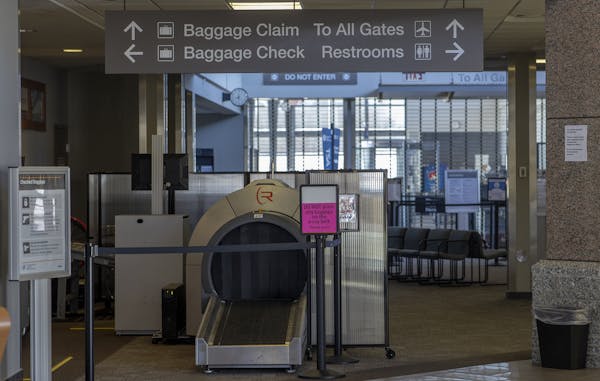Jules Hunter, a teacher from Illinois, has to get to Rochester frequently.
Her son, who has a rare form of epilepsy, is part of a clinical trial at Mayo Clinic. They fly into the Rochester International Airport every other week.
But lately, as regional airports around the country see lower departure and seat numbers for passengers, Hunter said the family is concerned about fewer choices in flights needed to make her son's appointments.
"I'm worried about it," she said. "But we've been lucky so far."
The decline in departures and capacity can be tied to an ongoing pilot shortage across the country that is pushing airlines to send pilots where they are most needed – bigger hubs – while some smaller regional airports get left behind, said Jack Penning, a managing partner at Volaire Aviation Consulting.
Some regional Minnesota airports — like Duluth and Rochester — have seen declining seat availability. Other airports have been left unscathed.
Rochester departures dropped from 4,208 in 2018 to less than 2,000 this year, according to Airline Data Inc. Departure numbers for the current year are subject to change.
United Airlines left the Rochester airport late last year, a decision that airport Executive Director John Reed said can be attributed to the pilot shortage.
Reed said the capacity that the airport offers is still adequate for community demand.
Rochester Mayor Kim Norton said it is hard to measure the impact that the shortage has had on the city because many passengers can choose to drive into Minneapolis to fly.
"I just think we're at this really difficult place right now. We're recovering from the pandemic," she said. "It's affecting all of us and I think we just have to keep that in mind and try to be patient and make accommodations as we can."
The Duluth International Airport also saw a decline. Between 2018 and 2022, departure numbers dropped by 239, according to Airline Data Inc. Seat numbers also fell.
The shortage has impacted the airport's plans to secure a new route to Denver that was supported by a grant from the Department of Transportation last year, according to Natalie Peterson, the director of communications and marketing for the Duluth airport.
"We did see the decline that everybody else did. We were able to weather through that ... pretty strongly," she said.
The airport was also able to add Sun Country flights to its roster during the pandemic.
Reed said the Rochester airport will recover. Sun Country is also adding flights there, and cargo and private flight numbers are higher than before, he said.
"We'll have an extra daily flight that begins this fall from American Airlines. So we're actually starting to feel like the airlines are adding stuff back — and to — our community," he said.
Other Minnesota airports have not been as impacted by the pilot shortage.
The Thief River Falls Regional Airport departure numbers fell over the last few years, but seat numbers have stayed constant because airlines are using larger planes, according to Airport Manager Joe Hedrick. The airport is also supported by an Essential Air Service grant, which guarantees service to airports through the Department of Transportation to avoid isolating small communities.
Brainerd Lakes Regional Airport, which also has a grant, has seen an increase in both departure and seat counts this year. Airport Director Steve Wright said SkyWest Airlines assured the airport it would do what it could to maintain service.
The shortage started when pilots chose to take early retirement deals when demand for flights was low at the start of the pandemic. Once passengers were vaccinated, the demand came back and the aviation industry struggled to fill the cockpits, Penning said.
Even without the pandemic, airlines anticipated a bit of a shortage because many pilots were coming up on the mandatory retirement age of 65, he said.
Many major airports in the U.S have had to cut service, too, Penning said.
Demand shot up much quicker than most airlines expected. He added that there is definitely more demand for travel in 2022 than there was before the pandemic started in 2019.
Norton pointed out that there are still other ways to travel to and from Rochester.
"As long as there are rental cars available and shuttles that run, I think we'll have a capacity to serve people," she said. "Just maybe not quite as conveniently as we would like."

Want to share info with the Star Tribune? How to do it securely

'Safe recovery sites' would offer syringes, naloxone and more to people using drugs. The plan could be in peril.
New Minnesota GOP leaders seek peace with party's anti-establishment wing

Who is Republican Lisa Demuth, Minnesota's first House speaker of color?

